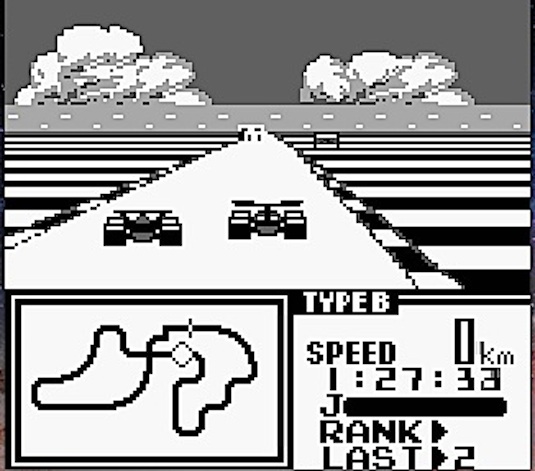
That was then and this is now. How does the game fare after the condescension of 27 long, long years? Well, as retro racers go (which, as you know, I'm partial to), it's not that bad. Sure, monochrome dot matrix, black and white, or some garish colours courtesy of the Super Game Boy aren't going to make it look as eye-catching as contemporaneous eight-bit racing games, but the familiar formula is solidly there. There's no plot. Just do two laps around each of the nine tracks, make sure you come first and then it's off to the next race. Simple, right?
F-1 Race shares its name with another racer Nintendo released on the Japanese Famicom in 1984. While that, a rip off of Namco's seminal Pole Position coin-op, was a very respectable effort for the time, Nintendo decided against porting it over and instead rewrote the game. In so doing, they also made it much, much tougher. F-1 Race is certainly the hardest racing game I've played in a long time that doesn't have broken controls. It's hard to put your finger on why it's a solid affair. Opponents' cars aren't a breeze to get by as they take up too much of the road, and as per most other genre racers pranging them or the scenery slows you right down - which is a big problem as coming first, particularly on the higher level tracks, means making perfect runs every single time. Indeed, there is no gentle easing you into the game. The first race is an okay trainer but after that only consistent play is going to get you through. This is a trip with guaranteed frustration as the destination, so it's just as well game over doesn't mean getting sent back to the beginning. You can carry on racing until you've beaten the level, though the scoreboard is there to remind the player of their multiple fails.
Nevertheless, in addition to being the first four-player hand-held game there are a couple of noteworthy mechanics that later made their way into loads of other racers. First, we have the jolly old nitro (or Jet, as it's styled here) for extra speed boosts. This is activated by holding down up on the D-pad, which can lead to not a few hairy driving moments. But combined with this, probably the first time they were seen together in a game, is slip streaming. Park your motor just behind an opponent for a wee second and your speed shoots up. Occasionally useful, but a bit of a pain if it causes you to plough into their rear end, knocking off valuable momentum and probably costing you the race. Also, as this is a Nintendo title they couldn't resist infiltrating some of their other properties into the game. Finish a race and you receive cameos from Mario universe characters, as well as Link from Zelda and Samus from Metroid.
Is it worth having a go now? In my view, all old games are worth a try. Even the bad ones. With F-1 Race we have a solid racer that ticked all the (then) established conventions and brought a few new ones to the table, which have subsequently become standard features in arcade-style racing. The difficulty, however, is punishing and the pay off probably isn't worth it - especially if you're reduced to playing it via emulation in single player mode. Perhaps one for masochist gamers and digital archaeologists seeking the lines of descent of commonplace mechanics.
1 comment:
Such an amazing game
Post a Comment